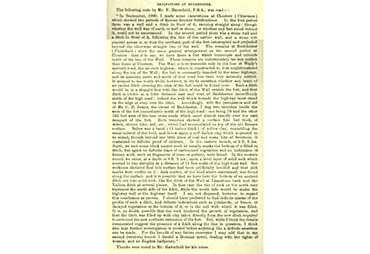Excavations 1901
The ordinary monthly meeting of the Society of Antiquaries of Newcastle upon Tyne was held in the library of the Castle, on Wednesday 28 August 1901 at 7pm. Mr F Haverfield reported that he had dug 2 trenches immediately North of the line of the Wall, as shown on the map, but did not find any definite evidence of a Roman ditch. He did, however, leave "a German novel, dealing with the rights of women, and an English halfpenny" in the Western trench, "For the benefit of any future excavator":

Excavations 1901
Click here for a high resolution scan in a new window:

Excavations 1901 Detail
Click here for a high resolution scan in a new window:

Publication
Click here for the full pdf document in a new window:
Excavations at Rudchester
From : Proceedings of the Society of Antiquaries of Newcastle upon Tyne volume 10, number 9, page 81-82
Publication Date: 1901
Author(s): F Haverfield
EXCAVATIONS AT RUDCHESTER. The following note by Mr. F. Haverfield, F.S.A., was read : — "In September, 1900, I made some excavations at Chesters (Cilurnum) which shewed two periods of Roman frontier fortifications. In the first period there was a wall and a ditch in front of it, running straight along: though whether the wall was of earth or turf or stone, or whether any fort stood behind it, could not be ascertained. In the second period there was a stone wall and a ditch in front of it, following the line of the earlier wall, and a stone fort planted across it, so that the northern part of the fort interrupted and projected beyond the otherwise straight line of the wall. The remains at Rudchester (Vindobala) shew the same general arrangement as the second period at Chesters: that is to say, we have there a fort which interrupts and extends north of the line of the Wall. These remains are unfortunately far less perfect than those at Chesters. The Wall is here traceable only by the line of Wade's military road, the modern highway, which is constructed in this neighbourhood along the top of the Wall ; the fort is necessarily bisected by the same highway, and its masonry north and south of this road has been very seriously robbed. It seemed to me worthwhile, however, to try to ascertain whether any trace of an earlier ditch crossing the area of the fort could be found here. Such a ditch would be in a straight line with the ditch of the Wall outside the fort, and that ditch is visible at a little distance east and west of Rudchester immediately north of the high road : indeed the wall which bounds the highway must stand on the edge or even over the ditch. Accordingly, with the permission and aid of Mr. C. H. James, the owner of Rudchester, I dug two trenches inside the area of the fort immediately north of the high road : one being 70 and the other 165 feet west of the four cross roads which meet almost exactly over the east rampart of the fort. Both trenches shewed a surface four feet thick, of debris, stones, tiles, soil, etc., which had accumulated on top of the old Roman surface. Below was a band (15 inches thick) of yellow clay, resembling the usual subsoil of the field, and below again a stiff darker clay which appeared to be mixed, though beyond one little piece of coal and some bits of freestone, it contained no definite proof of mixture. In the eastern trench, at 9 ft. 6 ins. depth, we met some black matter such as usually marks the bottom of a filled-in ditch, but again no definite trace of carbonized vegetation and no indication of human work, such as fragments of bone or pottery, were found. In the western trench we came, at a depth of 8ft. 9 ins., upon a level layer of solid rock which seemed to rise abruptly at a distance of 11 feet north of the high road wall. Our workmen declared that this surface had been artificially levelled and that pick marks were visible on it : dark matter, of the kind above-mentioned, was found along the surface, and it is possible that we have here the bottom of an ancient ditch cut into solid rock, like the ditch of the Wall at Limestone-bank and the Vallum ditch at several places. In that case the rise of rock on the north may represent the north side of the ditch, while the south side would be under the highway wall or the highway itself. I am not disposed, however, to regard this conclusion as proven. I should have preferred to find definite marks of the profile of such a ditch, and definite indications such as potsherds, or bones, or decayed vegetation at the bottom of it, or in the soil with which it was filled. It is, no doubt, possible that the rock hindered the growth of vegetation, and that the ditch was filled up with clay taken directly from the new ditch required to surround the new northern extension of the fort. But, while I think the details enumerated suggest the presence of a ditch along the line in question, I think also that further investigation is needed before anything like a definite assertion can be made. For the benefit of any future excavator I may add that in my second (western) trench I buried a German novel, dealing with the rights of women, and an English halfpenny." Thanks were voted to Mr. Haverfield for his notes.